Among the many heating schemes, the system with forced circulation of the coolant is distinguished by its versatility and wide functionality. It can be used in the heat supply of a small private cottage or apartment, as well as in a large multi-storey building. Is it difficult to do it yourself, without the involvement of specialists? Let us find out what is heating a house with forced circulation with your own hands, schemes and the optimal configuration of a particular system.
Features of forced circulation heating
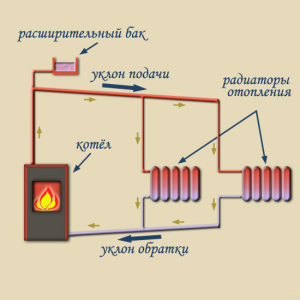
Modern water heating with forced circulation has replaced the gravitational scheme. In the second, the movement of the coolant is carried out due to the thermal expansion of water when it is heated. This principle significantly reduced the efficiency of heat supply.
One of the determining factors in the advisability of installing a water heating system with forced circulation is the relatively fast movement of the coolant along the line. Due to this, heat is evenly distributed over all radiators in the circuit.
In addition, it should be noted such features of heating by pumping groups:
- Possibility to install small pipes: 20, 25 mm. This reduces the total volume of warm water in the system, which affects the consumption of the energy carrier;
- Choice of several piping layoutsin. The forced heating system of a private house can be one-pipe, two-pipe or collector;
- Temperature control both for individual elements and for the entire system as a whole. Collector heating copes with this task best of all;
- Increased operating comfort.
However, along with this, it should be noted and the disadvantages that a two-pipe or one-pipe heating system with forced circulation has. First of all, this is the installation of a pumping group to increase the flow rate of the coolant. This entails an increase in primary costs, and also makes the operation of the entire system dependent on the supply of electricity. But these disadvantages are offset by the above advantages.
An existing gravity heating can be retrofitted. To do this, it is enough to install a pump. However, first you need to calculate the parameters of the system - not always large-diameter pipes are suitable for schemes with forced circulation.
Types of heating schemes with forced circulation
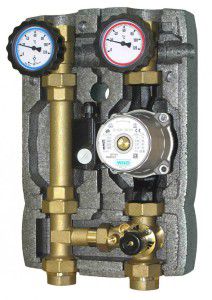
The basic principle of operation of a forced circulation heating system is to install pumps to increase the flow rate of the coolant. The place of their installation directly depends on the chosen piping layout.
In addition, the heating system of a private house with forced circulation must include security groups. This is necessary for the timely stabilization of the pressure in the pipes due to possible overheating of the coolant. Each type of forced circulation heating has a number of features that directly affect the choice in a particular case.But regardless of this, a do-it-yourself forced-circulation heating system, in addition to the pump, should include the following components:
- Security group: air vent and drain valve. Installed immediately after the boiler;
- Expansion tank... It is best to choose a membrane type design with the possibility of replacing the elastic valve;
- Each radiator trim must contain balancing valve, Mayevsky crane. It is advisable to install a thermostat;
- Shut-off valves... It is necessary to partially or completely shut off the coolant flow in a specific section of the system.
Each of the above components must have performance characteristics that match the parameters of a specific heating system. Otherwise, they will not perform the functions assigned to them.
The selection of certain components of the system is carried out according to a pre-made heating scheme for a house with forced circulation. The calculation should be as accurate as possible - using specialized programs or performed by professionals.
One pipe system
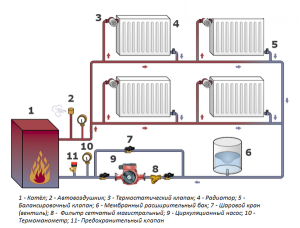
This is an outdated scheme that is practically not used for individual heating at home. In a one-pipe forced circulation heating system, there is only one supply line, in which radiators and batteries are connected in series.
The only advantage of this scheme is the small footage of pipelines. However, in addition to this, the one-pipe system has several significant disadvantages:
- Uneven distribution of the coolant. The further the radiator is located from the boiler, the lower the degree of heating of the hot water entering it;
- To carry out repair work, it is necessary to stop the heating boiler and wait until the temperature of the coolant drops to a normal level.
The pump power for one-pipe heating with forced circulation will be much less than for a two-pipe one. This is due to the smaller volume of the coolant in the system. Also, less space is required for laying pipelines - they can be installed under the floor, skirting boards.
For a one-pipe heating system with forced circulation, it is imperative to provide for the installation of a bypass for each radiator. This will make it possible to turn off the device without completely stopping the heat supply to the house.
Two-pipe system
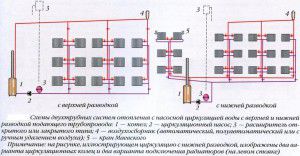
The scheme of a two-pipe heating system with forced circulation differs from a one-pipe heating system by the presence of one more line for the cooled coolant. It runs parallel to the main one and chilled water from the radiators enters it.
During the design of the system, it is necessary to correctly draw up the layout of the pipelines. The direct and return lines should be installed in close proximity to each other, but not more than 15 cm, in addition, the system can be with the same direction of movement of the coolant, with different vectors, as well as dead-end. Most often, a one-way directional scheme is chosen.
Forced circulation water heating has several important features:
- Small pipe diameters - from 15 to 24 mm. This will be enough to create the required pressure indicators;
- Possibility to install both horizontal and vertical piping;
- A large number of rotary elements will affect the hydrodynamic performance of the system for the worse. Therefore, they should be done as little as possible;
- When choosing a concealed installation, inspection hatches are installed at the pipe joints.
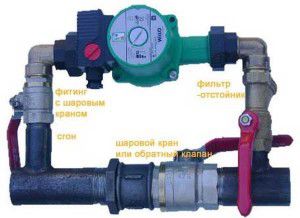
In each forced heating system of a private house, it is necessary to provide a bypass channel in the circulation pump unit. It is designed for the gravitational movement of the coolant in the event of a power outage.
The operation of the pumping equipment must ensure normal circulation in the system. To do this, you should correctly calculate its power and performance.
If the water heating system with forced circulation is equipped with polymer pipelines, they must be with a reinforced layer of aluminum foil or polyester.
Collector system

If the area of the house exceeds 150 m² or it has 2 or more floors, it is recommended to make a collector heating system with forced circulation with your own hands. It is one of the modifications of the two-pipe scheme and is designed to improve the efficiency of heat supply.
The main element of the collector heating circuit is the distributor. It is a pipe with a round or rectangular cross-section, on which several nozzles are installed. They are necessary for the distribution of the coolant along the individual heating circuits of the house.
A distinctive principle of operation of a heating system with forced circulation of a collector type is the arrangement of independent pipelines from each other. This makes it possible to regulate the heat transfer of each of them, and also stabilizes the pressure in the system.
A circulation pump is installed on each manifold branch pipe to ensure the proper speed of movement of the coolant. Such a heating system for a private house with forced circulation has a number of important features:
- Increase in the number of pipes and fittings. Each circuit is a separate heating system connected by a collector into a single network;
- To adjust the volume of the coolant, special elements are needed - thermostats and servo drives with temperature sensors;
- For the most efficient operation of the system, it is recommended to install a mixing unit. It connects the direct and return pipes and mixes the water flows to achieve the optimal temperature of the heating medium.
The collector circuit for heating a house with forced circulation can consist of several distribution nodes. It all depends on the total area of the house, as well as the location of the premises in it.
The sum of the diameters of the pipes on the manifold must not exceed its cross-section. Otherwise, there will be a destabilization of the pressure in the system.
Design of forced circulation heating
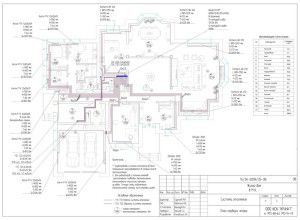
The primary task in the independent installation of water heating with a circulation pump is to draw up the correct scheme. To do this, you need a house plan, on which the location of pipes, radiators, valves and security groups is applied.
System calculation
At the stage of drawing up the diagrams, it is necessary to correctly calculate the pump parameters for the forced heating system of a private house. To do this, you can use special programs or do the calculations yourself. There are a number of simple formulas to help you calculate:
Pн = (p * Q * H) / 367 * efficiency
Where Rn - rated power of the pump, kW,R - the density of the coolant, for water this indicator is 0.998 g / cm³,Q - the level of the coolant consumption, l,H - required head, m.
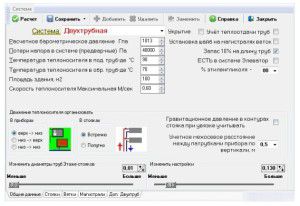
To calculate the pressure indicator in the forced heating system of a house, it is necessary to know the total resistance of the pipeline and heat supply as a whole. Alas, it is almost impossible to do it yourself. To do this, you should use special software packages.
Having calculated the resistance of the pipeline in a hot water heating system with circulation, you can calculate the required pressure indicator using the following formula:
H = R * L * ZF / 10000
Where H - calculated head, m,R - pipeline resistance,L - length of the largest straight section of the highway, m,ZF - coefficient, which is usually equal to 2.2.
Based on the results obtained, the optimal model of the circulation pump is selected.
If the calculated pump power indicators for a self-installed forced circulation heating system are large, it is recommended to purchase paired models.
Heating installation with circulation
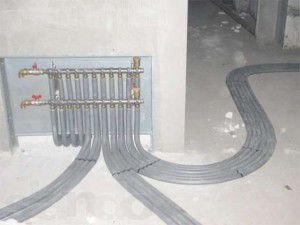
Based on the calculated data, pipes of the required diameter are selected, and shut-off valves to them. However, the diagram does not show the way of installing the trunk. The pipelines can be installed in a hidden or open way. The first is recommended to be used only with full confidence in the reliability of the entire heating system of a private cottage with forced circulation.
It must be remembered that the quality of the components of the system will determine its performance and performance. This is especially true for the material of manufacture of pipes and valves. In addition, for a two-pipe heating system with forced circulation, it is recommended to heed the advice of professionals:
- Installation of an emergency power supply for the circulation pump in the event of a power outage;
- When using antifreeze as a coolant, check its compatibility with the materials for the manufacture of pipes, radiators and boiler;
- According to the heating scheme of a house with forced circulation, the boiler should be located at the lowest point of the system;
- In addition to the pump power, it is necessary to calculate the expansion tank.
Circulation-type heating installation technology is no different from the standard one. It is important to take into account the features of the contour house - the material for making the walls, its heat losses. The latter directly affects the power of the entire system.
Analytics of the parameters of heating systems with forced circulation will help to form an objective opinion about it:







